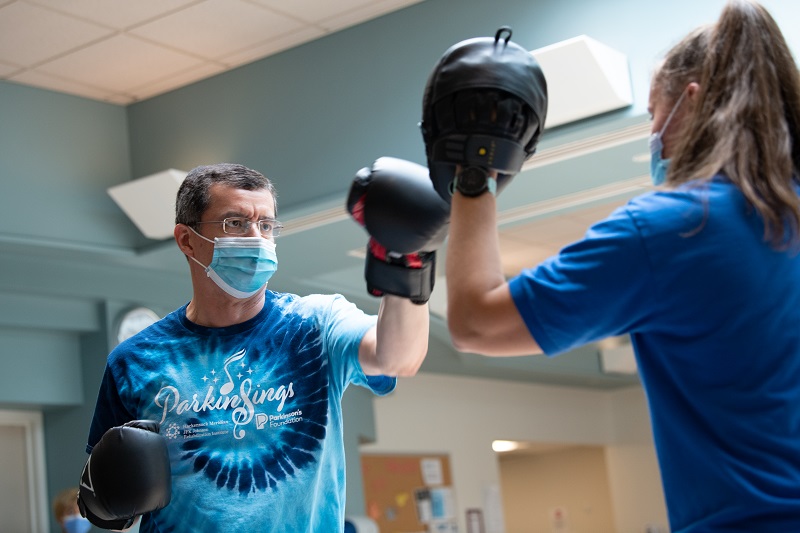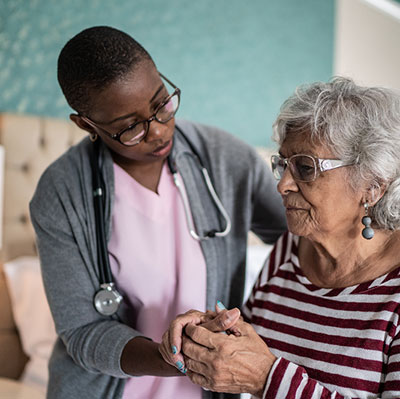Support Services Give Parkinson’s Patients Healing and Purpose

April 24, 2023
For the 1 million people living with Parkinson’s disease in the U.S.—shaking, stiffness, and difficulty walking and talking become a daily reality. Living well with this progressive neurological condition takes a village. But these inpatient and outpatient services can help patients better control symptoms and maximize their abilities.
PingPongParkinson®
What It Is: PingPongParkinson is a non-profit with local chapters that host weekly ping-pong exercise groups for people living with Parkinson’s disease. It provides opportunities for physical, cognitive, and social engagement.
Why It Helps: Ping-pong (or table tennis) can help people with Parkinson’s disease maintain their coordination and fine motor skills. The idea is based on the concept of neuroplasticity, the brain’s ability to make new nerve cells and connections through challenging exercise. Although medication remains the main treatment focus for Parkinson’s, compelling evidence suggests regular exercise significantly helps manage the disease.
Parkinson’s Wellness Program
What It Is: A unique two-week inpatient rehabilitation program at JFK Johnson Rehabilitation Institute, the Parkinson’s Wellness Program aims to help patients actively address any decline or required medication changes to enhance as much functionality as possible. After completing the inpatient admission, patients may transition to outpatient services.
Why It Helps: The program empowers patients to develop and meet their own individual goals, which can range from scaling back medication dosages to avoiding falls, improving voice quality or just functioning better during daily activities. SPEAK OUT! Combines both education and one-on-one speech therapy, while LOUD Crowd promotes accountability, camaraderies and encouragement through group sessions.
Rock Steady Boxing
What It Is: Rock Steady Boxing is a non-profit Parkinson’s wellness exercise program that uses a surprising technique—non-contact boxing—to support people with Parkinson’s disease. Its regimen was largely adapted from boxing drills, helping patients beat back the “opponent” with rigorous exercises.
Why It Helps: The exercises focus on improving speed, agility, hand-eye coordination, footwork and overall strength to empower people with Parkinson’s and instill a renewed sense of hope.
ParkinSINGS
What It Is: Through a Parkinson’s Foundation community grant, JFK Johnson Rehabilitation Institute offers the ParkinSINGS choir that brings together Parkinson’s patients for fun and vocal fitness.
Why It Helps: Parkinson’s disease can weaken speaking and swallowing, but research shows that singing can help maintain the muscles involved in these key tasks. Plus, the choir also promotes camaraderie and social interaction.
Support Groups
What It Is: Hackensack Meridian Health runs support groups at hospitals throughout the network that meet at various days and times. Some of the groups also meet virtually.
Why It Helps: Parkinson’s patients, along with their caregivers, benefit from sharing their challenges and triumphs with others going through the same experience.
Smartphone Apps
What It Is: Working with Abbott Laboratories, Hackensack Meridian Health uses a wireless app to remotely adjust electronic stimulation levels for patients who have undergone deep brain stimulation (DBS) surgery, which implants a pacemaker-like device in the brain to control tremors, stiffness and other Parkinson’s symptoms. Another partnership, with medical device company Medtronic and Rune Labs, offers Parkinson’s patients a free Apple watch if they use a Medtronic battery in their DBS device. With the Apple watch, patients can use motion-sensing software to better manage their disease by tracking aspects such as sleep, tremor frequency and abnormal movements that persist after medication use.
Why It Helps: At the touch of a button, these smartphone apps connect Parkinson’s patients with information and resources that can help monitor symptoms and tweak certain therapies.
Next Steps & Resources:
- To find a neurologist near you, call 800-822-8905 or visit our website.
- Learn more about these programs as well as treatment for Parkinson’s disease, essential tremor and other movement disorders.
The material provided through HealthU is intended to be used as general information only and should not replace the advice of your physician. Always consult your physician for individual care.





